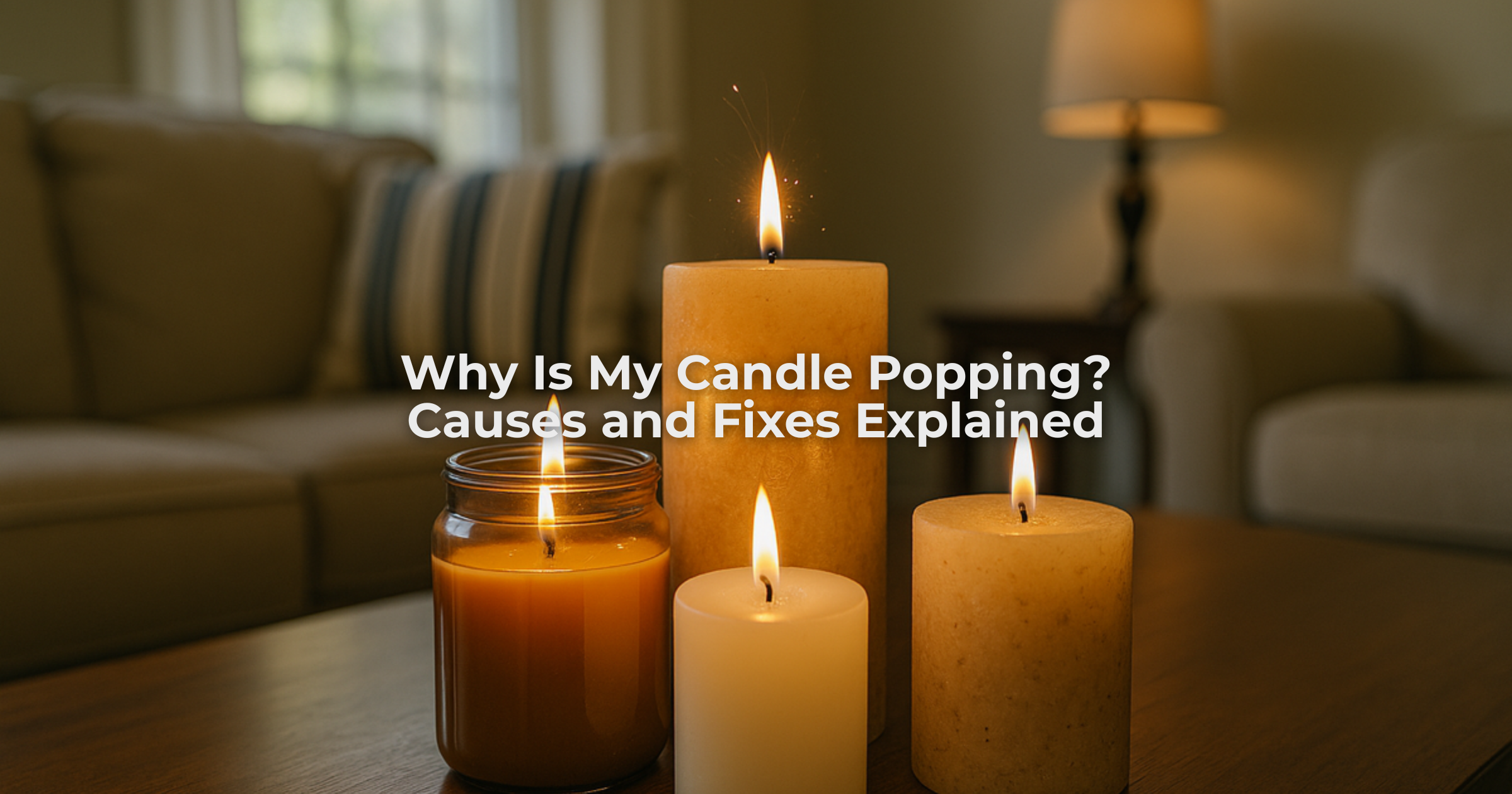No products in the cart.
Why Is My Candle Popping? Causes and Fixes Explained
- Nav Preet
- No Comments

When you light a candle and hear small pops or crackles, it’s not just a random sound. Candle popping happens when moisture, trapped air, or impurities inside the wax or wick interrupt a clean, steady burn.
As the flame heats these pockets, the built-up pressure bursts, creating that sharp sound. While it might seem harmless, continuous popping can shorten burn time, cause uneven melting, or even scatter hot wax.
I’ve faced this issue countless times while testing soy and paraffin blends in my studio. It often occurred after rushing the curing process or storing candles in a damp cabinet.
Over time, I learned that every pop tells a story about what went wrong the wick, wax, or environment.
In this guide, I’ll explain the real reasons your candle makes popping or crackling noises, how to fix them, and what steps prevent it from happening again.
Whether you buy candles or pour your own, understanding the science behind that sound helps you burn safely and beautifully every time.
Why Is My Candle Making Popping or Crackling Sounds?
Several factors contribute to this behavior, and identifying the cause is the first step toward a consistent, soot-free burn.
1. Moisture in the Wax
Moisture is the most common culprit. When water droplets hide inside cured wax, they instantly vaporize under heat, producing a popping sound.
This often happens if candles are made or stored in humid spaces, or if wax is poured before fully cooling.
According to Craftovator, even small water residue in the candle vessel can cause spitting or popping once the flame reaches it, which confirms how sensitive wax composition is to moisture exposure.
The fix lies in proper curing and storage keep candles in a cool, dry area and ensure the wax rests for at least a week before lighting.
2. Wick Containing Impurities or Moisture
Sometimes the issue lies in the wick itself. A wick that has absorbed moisture or wasn’t properly primed can lead to irregular combustion.
Before lighting, trim your wick and focus on choosing the right wick size to ensure a steady flame.
When this happens, the flame burns unevenly, and each tiny droplet of moisture reacts with the wax, producing faint crackles. Low-quality or untreated wicks often carry leftover chemicals that add to the noise.
Before lighting, trim your wick to about one-fourth of an inch and make sure it’s dry. In my experience, cotton and wooden wicks from reliable suppliers provide a smoother, cleaner flame with minimal popping.
3. Air Bubbles Trapped in Wax
If you pour wax too quickly or at the wrong temperature, air pockets form within the candle body. When heat reaches these tiny voids, the trapped air expands and bursts.
This not only causes popping but also affects how evenly the candle burns. Pour slowly, at the right temperature, and gently tap your container to release bubbles before curing.
4. Excess Fragrance Oil or Additives
Using too much fragrance oil or unfiltered additives can make the wax unstable. When burned, these extra compounds combust unevenly, creating audible crackles.
Always follow fragrance load guidelines (usually under 10%) and clean your jars before pouring. Clean wax equals a calmer, quieter flame.
5. Drafty or Unstable Burning Environment
Airflow plays a huge role in candle performance. If your candle sits near an open window, fan, or air vent, the flame constantly flickers.
This uneven oxygen supply leads to irregular wax melting and popping sounds. Place candles away from moving air and keep them on a flat, heat-resistant surface for the best results.
How to Prevent Candle Popping?
Once you know what causes candle popping, prevention becomes simple. Start by controlling moisture. Always store candles in a cool, dry cabinet away from humidity or sudden temperature shifts.
If you make candles at home, let them cure for at least one to two weeks before lighting. This ensures all excess oils and air escape naturally.
Trim the wick before every burn. A long or frayed wick draws more wax than it can burn, leading to inconsistent flames and small bursts of air or soot. Use a wick trimmer or sharp scissors for accuracy.
Clean containers also matter. Dust, lint, or leftover wax residue can create tiny combustion points that disturb the flame. Wipe jars with isopropyl alcohol before pouring or relighting.
Lastly, be mindful of the environment. Burn candles away from open windows or fans and always place them on a stable, flat surface. Controlled airflow equals a steady, peaceful burn.
Final Thoughts
Candle popping is rarely dangerous, but it signals that your wax or wick needs attention. By fixing moisture, air, and wick issues, you can enjoy longer, cleaner, and quieter burns.
I’ve tested dozens of blends over the years, and once these basics were right, every candle burned beautifully.
Curious about formats and materials? Explore types of candles for different burn behaviors.
If you prefer ready-made candles crafted with care and premium wax blends, explore Karigar Style.
Our hand-poured candles follow these best practices, giving you that serene glow without the unwanted crackle.

Nav Preet is the founder and creative soul behind Karigar Candles. Inspired by heritage, nature, and the warmth of handmade artistry, she crafts candles that do more than glow—they evoke emotion. Through this blog, she shares her love for scents, styling, and mindful living, one flame at a time.
Creative Head at Karigar Style







